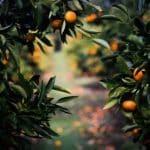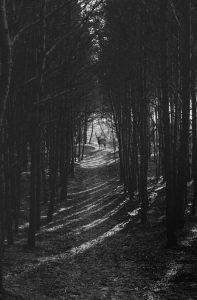We talk about the sea reclaiming the land, as if this wasn’t a cycle through geological time—or one being forced now by anthropogenic climate change. We talk about building on land reclaimed from the sea, as if it was ever ours to own. We talk about rivers reclaiming floodplains. Reclamation sounds like something powerful: a deliberate act of assertive people who know what they’ve lost, or simply what they want, or of Nature, who doesn’t care about such human desires.
My experience of reclamation is that it can be more subtle, less intentional.
There are things I’ve reclaimed that I recall having in my own lifetime. As a small child, I loved running around the playground and hanging upside down on the bars. That was until school sports and PE classes intruded: kids making fun of hairy legs, a teacher who broke my nose trying to ‘help’ with a flip I could have managed alone, another shouting at me to do push ups properly. Although I started making gym trips of my own volition as a university student, it was mostly an escape from the lab, not a joy in itself.
Then, aged 21, I spent several weeks on fieldwork in Antarctica, and stopped at home on the way back overseas. I’d never been on an extended field campaign until I spent that time living and working on a volcano with colleagues I’d only recently met and an instrument I’d never seen before. When I visited the studio where I’d taken dance classes until a few months earlier, my former teacher said, ‘You’re different.’
‘Physically or mentally?’
‘Both,’ he said, sensing a strength and confidence I was still getting used to.
The significance of this change became clear some years later, sitting in the kitchen of an old school friend. Talking about our difficult relationships with exercise and our bodies, I explained it like this: ‘I used to believe I was a brain in a body. Now, they’re both me.’
For me, this was a result of movement I enjoyed. By then I’d done several field expeditions. I was learning bharathanatyam (a South Indian classical dance), trail running, caving, climbing; doing mixed martial arts, pilates, yoga…and had developed a seemingly new ability to consciously move—and sense—my body. Although I must have had this connection within myself as a child, I hadn’t been aware of it. I hadn’t even been aware of losing it somewhere in my school PE yard, until I reclaimed it; and I spent the next decade finding new ways to reclaim it, until it all disappeared again. Still, having learned that connection once, I remind myself my body is not just the place I live in—it is me. That offers hope of new, gentler ways to reclaim my physical body and care for my health.
I’ve long known that South Asians are more prone to heart disease and diabetes than most ethnic groups, but research now suggests links between the colonial history of the region—specifically, famines caused by the British exporting much-needed grain—and this genetic predisposition, which continues generations after the end of that Empire[1,2]. Storing visceral fat is conducive to surviving starvation; not so much to surviving a typical high-calorie, low exercise, middle-class lifestyle. It’s satisfying to think that merely by existing as myself—running, climbing, dancing—before learning about this, I was reclaiming my body from more than just PE classes and school bullies.
Exercise isn’t an option for everyone—it’s rapidly becoming less of an option for more of us in this pandemic, and might not be enough to stave off genetic predispositions anyway. But do we have to be aware, or successful, to be engaged in reclamation? Can symbolic reclamation compare to total, physical, reclamation?
The version I know of my family’s home province, Jaffna—or really, யாழ்ப்பாணம் (Yāzhppānam,); even the common name for it is a remnant of Portuguese rule)—comes from my parents’ and grandparents’ stories. What I consider my inherited culture is also heavily influenced by colonisation. Why is it that my mother considers it inappropriate for women to have bare shoulders when women of her grandmother’s generation would have worn a sari without a blouse? Which of these cultures is ours, and which derives from colonial British values about how women should behave that permeated her immediate forebears’ middle-class, caste-privileged, upbringing?
If we go back a little further, Jaffna in the mid-1800s (and in its third round of colonisation after the Portuguese and Dutch were replaced by the British) was experiencing a religious revival in reaction to the spread of Christianity. Led by Ārumuga Nāvalar (who studied English in a Methodist school), this movement may have limited the success of missionaries, but in other ways effectively promoted a shift towards contemporary Victorian ideals. Nāvalar’s reforms [3] emphasised agamic (orthodox) Saivism at the expense of small deity worship and reinforced the local caste system—a prescriptive form of ‘Hinduism’ that appears modelled after the contemporary Christianity he had studied. He opposed traditional dancing at temples [3]—equating dancers with prostitutes [4]— and proposed strict rules for behaviour, not just in temples, [5] but also in daily life. He wrote essays and guidelines replete with casteism [6], sexism, and patriarchal attitudes [7,8]. Even in his resistance to colonisation of religion, much was lost. Given that relatively recent history, what exactly is and was Yāzhppāna Tamil culture?
Untangling those influences seems impossible, especially for a second generation diasporan. There is no scope for total reclamation. Instead, I glean what I can from my family and community, seeking to stay connected with the culture we came from, whether by attempting to read ancient Tamil literature or learning classical dance. In my childhood, I learned bharathanatyam, as we knew it, from my mother and then a local teacher. As an adult, I took regular classes for nearly two years. I could appreciate it by then as a beautiful way to communicate and tell stories with one’s body; as a way to ground oneself in the physical; and as a dance form with a long tradition behind it that previous generations of my family had also loved.
Except that what most of us call bharathanatyam began as a traditional dance form of the Isai Valluvar hereditary caste in South India. Its practitioners were dispossessed on two fronts: colonial laws targeted the original dancers, banning traditional customs (you may recall that Nāvalar shared some of these prejudices), and the dance was ‘reclaimed’ by Brahmin dancers [9] through the mid-20th century. The forms most commonly taught today are this latter version—stripped of elements considered inappropriate by colonial viewers—while the original dancers have been both disinherited and discriminated against. In recent decades, this new bharathanatyam has become more broadly identified with heritage and identity, including among Eelam Tamils and in the diaspora. For many, sending children—especially girls—to dance classes is a way to preserve culture. Yet, as the educational work of hereditary dancers such as Nrithya Pillai shows, this perceived ‘reclamation’, divorced from the history of the dance, obscures the colonial suppression and, importantly, continued dispossession of the original dancers and their communities by those with caste privilege.
As Maria and Monique wrote in ‘What does ‘Reclamation’ mean to Apparition Lit?’[10], reclamation comes with the realisation that what we lost comes back different. But it’s not just that: when we don’t know, or can’t fully comprehend, what we’ve lost, what are we really reclaiming—and was it ever ours?
Growing up in Aotearoa New Zealand, it is impossible not to be at least partially aware of what we have lost. Extinct giant eagles, moa, and huia; the ongoing search for the South Island kōkako [11]; the myriad plant and animal species we are constantly on the verge of losing.
This is a colonised country, and the history of colonisation tells us there is rarely a spectacular, definitive reclamation. To me, it seems there is an uneasy equilibrium between reclamation and what continues to be colonised. Limited return of land to tāngata whenua, thanks to Māori-led policy and activism, goes alongside other public policy that discriminates against indigenous people [e.g. 12]. And while we have natural parks and major conservation efforts to preserve endangered wildlife, we also have large-scale dairy farming; monoculture pine damaging soils, waterways, and ocean habitats; and continued exploitation of fossil fuels—all despite decades-old knowledge of their harmful environmental impacts.
During cyclones earlier this year, logging debris from pine plantations washed into stream channels and was strewn across beaches in Tairāwhiti and Wairoa in the northeast of the country. We could call this nature reclaiming a human landscape, but it isn’t good for nature, either. Earth’s reclamation is secular, indifferent. These changes will continue. Some other short-term equilibria may be established. From the human angle, though, it’s not just soils, slopes, waterways, beaches, ocean floor, and the habitats therein—it’s also the people who live in these areas and work in these plantation forests, and all the other life-forms that suffer due to our poor decision-making. Do we push against the reclamation of nature, or do we work with it? We may not know exactly what’s been lost, but can we recall what equilibrium these landscapes were once in, and learn how to best return to that?
Or maybe reclamation isn’t always our right. Maybe our duty, sometimes, is stepping back so that someone or something else can do the reclaiming. We can’t ignore this. Even when we are the ones who have lost, or been robbed, finding ways to reclaim a sense of self, our language, our culture: if we don’t know what we are really trying to reclaim, or why, we—especially those of us with other types of privilege, including wealth, education, class, or caste privilege—may facilitate the dispossession of others.
While a river breaking out across urbanised floodplains may be returning to its original, natural path, it also picks up debris and pollutants. What, ultimately, do we want back? Is it a perceived pre-colonial version of our cultures that still has inbuilt prejudice and oppression? Were such systems even real in our ancestral past? Quite possibly; pre-colonial societies must have had their own social problems. Whatever the history, though, we have a choice to reclaim judiciously: to take back only what we need to create something new and equitable. If we are aligned with those who have done the taking, we can facilitate stepping back so that others can repossess their land and way of life.
I’ll reclaim my body, and keep reclaiming it. As for the rest… My idea of what it is to be Yāzhppāna Tamil changes every time I learn something new. A dance I once thought of as my heritage is actually someone else’s. For these—the things we never had—I hope we can grow our understanding, and figure out a new approach together. Some types of reclamation were always going to be symbolic; the things we reclaimed were always going to come back changed. Why shouldn’t we change it for the better? Pick out the debris, swallow the alluvial plains, reshape the landscape. Reclamation that is too broad and ill-informed—reclamation that does not look to the future and the health of our communities and planet—continues to let colonialism win. But what if, instead, it is a mindset of equity, where we listen and find ways to empower one another, so we can all reclaim our agency?
Tehnuka (she/they) is a Tamil tauiwi writer and volcanologist from Aotearoa New Zealand. She likes to find herself up volcanoes, down caves, and in unexpected places; everyone else, however, can find her online at www.tehnuka.dreamhosters.com, and some of her recent/forthcoming writing in Frivolous Comma, The Deadlands, and Augur.
FOOTNOTES:
- Syed, M.I., Deek, F., Shaikh, A., 2022. The Susceptibility of South Asians to Cardiometabolic Disease as a Result of Starvation Adaptation Exacerbated During the Colonial Famines. Endocrinology, Diabetes and Metabolism Journal, 6(22):1-9. doi: 10.31038/EDMJ.2022621
- Faima Bakar, March 2022. How History Still Weighs Heavy On South Asian Bodies Today. The Huffington Post. https://www.huffingtonpost.co.uk/entry/south-asian-health-colonial-history_uk_620e74fee4b055057aac0e9f
- Hellmann-Rajanayagam, D., 1989. Arumuka Navalar: Religious reformer or national leader of Eelam. The Indian Economic & Social History Review, 26(2), 235–257. doi:10.1177/001946468902600204
- Ārumuka Nāvalar, 1955. Nallūr Kandaswāmy Kōyil, Pirapandaththiraddu, vol 2 compiled by Tha. Kailāsapillai, Vithyānupālana Press, Chennai, 3rd ed.
- Ārumuka Nāvalar, 1954. Anāsāram (‘Unapproved practices’), Pirapandaththiraddu, vol 1 compiled by Tha. Kailāsapillai, Vithyānupālana Press, Chennai, 3rd ed.
- Ārumuka Nāvalar, 1954. Thirukkōyililum thiruvīthiyilum cheiyyaththakātha kuttrangal (‘Sins not fit for the temple and the temple street’), Pirapandaththiraddu, vol 1 compiled by Tha. Kailāsapillai, Vithyānupālana Press, Chennai, 3rd ed.
- Ārumuka Nāvalar, 1939. Penkalvi, Pāla pādam 3. Vithyānupālana Press, Chennai, 11th ed.
- Ārumuka Nāvalar, 1950, Pāla pādam 4. Vithyānupālana Press, Chennai, 29th ed.
- Nrithya Pillai, June 2022, Cycles of cultural violence within performance and scholarship of Bharatanatyam. The News Minute. https://www.thenewsminute.com/voices/cycles-cultural-violence-within-performance-and-scholarship-bharatanatyam-165159
- Apparition Lit, August 2023. ‘What Does ‘Reclamation’ Mean to Apparition Lit?’ https://apparitionlit.com/what-does-reclamation-mean-to-apparition-lit/
- Carissa Wong, 19 August 2023, Possibly heard, and maybe seen, the search for the South Island Kōkako continues’. Re:wild. https://www.rewild.org/news/possibly-heard-and-maybe-seen-the-search-for-the-south-island-k-kako
- Mutu, Margaret. 2020. ‘Māori of New Zealand’ in Sharlotte Neely and Douglas Hume (eds) Native Nations: The Survival of Indigenous Peoples, 3rd edition. Vernon, British Columbia, Canada, JCharlton Publishing. pp. 87-114.






